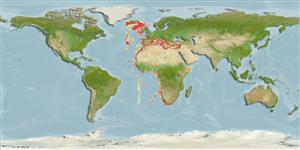>
Ophidiiformes (Cusk eels) >
Bythitidae (Livebearing brotulas)
Etymology: Cataetyx: Greek, kata = down + Greek, etix, stixo, stizo = to prick, to puncture.
Environment: milieu / climate zone / depth range / distribution range
นิเวศวิทยา
เกี่ยวกับทะเล,น้ำเค็ม สัตว์หน้าดินในเขตน้ำลึก; ระดับความลึก 500 - 2400 m (Ref. 34024). Deep-water; 64°N - 36°S, 29°W - 35°E
Eastern Atlantic: scattered localities around the British Isles, Azores and France, along the coast of West Africa to the Cape of Good Hope; also recorded from the western Mediterranean. Reported from Iceland (Ref. 12462). Reported from the Gulf of Mexico (Ref. 37039).
Length at first maturity / ขนาด / น้ำหนัก / Age
Maturity: Lm 35.0, range 30 - 40 cm
Max length : 65.0 cm TL เพศผู้/กระเทย; (Ref. 37039)
Short description
เครื่องมือที่ใช้ในการแยกชนิดสัตว์,สิ่งมีชีวิตออกจากกัน | สัณฐานวิทยา | ความยาวต่างๆ
เงี่ยงครีบหลัง (รวม) : 0; ก้านครีบอ่อนที่หาง (รวม) : 98 - 107; เงี่ยงครีบก้น: 0; ก้านครีบอ่อนที่ก้น: 75 - 83; สัตว์มีกระดูกสันหลัง: 60 - 61. Branchiostegal rays 8.
Uncommon bathydemersal or benthopelagic species (Ref. 34024). Viviparous (Ref. 4758).
Life cycle and mating behavior
Maturities | การสืบพันธุ์ | Spawnings | Egg(s) | Fecundities | ตัวอ่อน
Nielsen, J.G., D.M. Cohen, D.F. Markle and C.R. Robins, 1999. Ophidiiform fishes of the world (Order Ophidiiformes). An annotated and illustrated catalogue of pearlfishes, cusk-eels, brotulas and other ophidiiform fishes known to date. FAO Fish. Synop. 125(18):178p. Rome: FAO. (Ref. 34024)
IUCN Red List Status (Ref. 130435)
Threat to humans
Harmless
Human uses
การประมง: ไม่มีผลประโยชน์
เครื่องมือ
Special reports
Download XML
แหล่งที่มาจากอินเตอร์เน็ต
Estimates based on models
Preferred temperature (Ref.
123201): 3.7 - 13.2, mean 6.5 °C (based on 300 cells).
Phylogenetic diversity index (Ref.
82804): PD
50 = 0.5002 [Uniqueness, from 0.5 = low to 2.0 = high].
Bayesian length-weight: a=0.00457 (0.00179 - 0.01169), b=3.10 (2.87 - 3.33), in cm total length, based on LWR estimates for this (Sub)family-body shape (Ref.
93245).
ระดับชั้นอาหาร (Ref.
69278): 3.7 ±0.6 se; based on size and trophs of closest relatives
ความสามารถในการกลับคืนสู่ปกติ (Ref.
120179): ต่ำ, เวลาต่ำสุดที่จะทำให้ประชากรเพิ่มขึ้นเป็น 2 เท่าใช้เวลา 4.5 - 14 ปี (Preliminary K or Fecundity.).
Fishing Vulnerability (Ref.
59153): Moderate to high vulnerability (46 of 100).
Nutrients (Ref.
124155): Calcium = 22.5 [12.7, 52.3] mg/100g; Iron = 0.415 [0.209, 0.860] mg/100g; Protein = 15.7 [13.2, 18.1] %; Omega3 = 0.282 [0.140, 0.581] g/100g; Selenium = 31.4 [12.0, 77.2] μg/100g; VitaminA = 7.14 [1.37, 35.40] μg/100g; Zinc = 0.463 [0.287, 0.731] mg/100g (wet weight);
